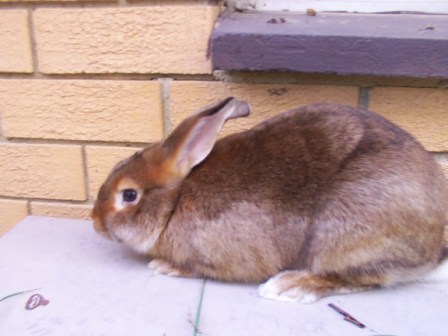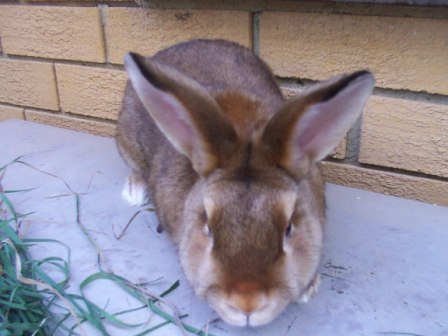

THE SATIN RABBIT - Nikki White (Reguli Cavy & Rabbit Stud)


This is a medium-sized, cobby rabbit with soft, dense fur whose chief feature is the semi-translucent hair shaft which gives their coat its distinctive lustrous sheen. The gene for satinisation is recessive and it can be found in other species besides rabbits, namely the cavy (guinea pig), the mouse and the cat (one breed only, the Bengal). Colours seem more intense in the Satin because of this translucent hair shaft which allows the colour granules to shine through. Plus the light reflects off it like glass.
Fortunately, most Satins are as beautiful in their natures as they are in looks. They are placid and gentle and tolerant of lots of handling even by small children who cart them around upside down (as happened to an Opal doe of mine many years ago. She just seemed to sigh resignedly, “I can do this”). They have been called the “pyjama cases” of the fancy. However, they are not boring and have plenty of personality.
They are soft and shiny and the sheen in some colours such as Orange, Opal or Cinnamon can be absolutely stunning. The Castors gleam like burnished chestnuts. They are inclined to be a somewhat soppy rabbit - you can do almost anything with them. There are exceptions, of course, as with any breed of any species. They will sit happily in a child's lap like a cat and many breeders recommend them as children's pets. They are usually patient and friendly and less fragile than some of the dwarf breeds whom the very young children can startle, overtire and half strangle in their enthusiasm. To parents who might object that their little darling can't pick up a Satin as easily as a Netherland dwarf, the answer is: "Can they pick up the family cat or dog?" A rabbit this size can teach respect in handling it, just like a cat or a dog.
They are a Fur rabbit and the BRC Breed Standard requires the rabbit's coat to have an "exquisite satin-like texture and sheen. The hair length should be 2.54-3.17cm but sheen, texture and density should be more important than length." The coat should roll back when stroked in the reverse direction. The adult must weigh between 2.72-3.62 kg. A somewhat cobby rabbit with a slightly arching back, it should have a broad head of medium size on a short neck with medium length, well-furred ears carried evenly and in proportion to the head.
Faults are woolliness of coat, white hairs in coloureds and white patches in all Agouti Satins. Disqualifications include flyback coat and being overweight in under 5 months classes and underweight in the adult classes. This last can be a problem when your Junior becomes and Adult as they are often not the required weight. I usually pull them off the bench once they turn Adult until they reach the required adult weight.
Satins come in the full range of colours. About ten years ago the "Ivory" (that is, either a red-eyed White or a blue-eyed White, so called because the fur has the creamy tinge of ivory) was the most popular in the ACT/NSW. This is the colour that has the density and is useful for putting back through your coloured lines to improve the coat. As I bred Agouti Pattern (Castor and Opal), I found it hard to get stock.
Now I see this has all changed and it is coloured Satins you see most with Orange being very popular. However, it does seem to me that the Satins of today lack the size of those of the late 90s and early 2000s and that includes my own.
Density and softness are as important as sheen and the coat is worth 40 of the 100 points with colour and pattern accounting for 30 more and type 20.
I had a Sooty Fawn Satin doe years ago who had lovely satinisation but a somewhat open, flyback coat, lacking density. The Castor buck I put over her has a much denser coat but still not as dense as it could be but made up for this with good satinisation, type and colour. Consequently, none of their kits were going to be very brilliant. They made beautiful pets, though,. So I sold her as a pet (she had a very gentle nature) and bought an Ivory doe with a very dense coat and their offspring has\d a lovely dense coat and satinisation.
HISTORY
In 1932, Mr W. Huey, of Ohio, USA, who was breeding Havana Rex, found a darker litter than usual which seemed to have a glow about them. He asked the advice of two other breeders of Rex and as a result the Satin potential was recognised and seized. Experimentation revealed the satin factor could be created with other colours in other rabbits. So an Orange Satin was made from a Havana Satin. Rex appear to have played an important part in developing the Satin as a New Zealand White, bred from an Ermine Rex sire and a Californian dam, was mated to a Havana satin to produce white.
The Satin did not appear in England until 1947 when some Ivories were imported. Ivory still remains the most popular colour over there.
WHAT TO LOOK FOR
A good dense coat with no woolliness which doesn't fly back when stroked the wrong way but falls back into place slowly. There should be plenty of coat at the nape and it should be of an even length. The coat should also be evenly shiny and not just in patches. They are a chunky, short-necked rabbit and should not be long and snaky like a Rex nor should they be too fat nor too small. Beware of excessive dewlaps in the does and rolls of fat round the body.
An odd thing I’ve found over the years is that though people like the look of them, “ooh” and “aah” over the coat ands admire their softness and gentleness, few actually want to buy them.
HOUSING AND CARE
A Satin is not a small rabbit nor particularly large and it is not a terribly active rabbit, being built for comfort, not for speed. I keep some in cages 120cm long by 70cm by 70cm and others in cages 110cm by 60cm by 50cm. Feed is as for other breeds - pellets, mix, fresh fruit and veg, as treats. Don't over feed. Their coats can be brought to a fine sheen by brushing with your hands and/or a piece of silk or satin cloth or mitt. Like all rabbits, they should be brushed with a slicker brush or comb in moult and given plenty of roughage (meadow hay or lucerne) during these times. Also watch that they don't get hot - their dense fur makes them more susceptible in the heat than many other breeds. They are basically an easy care rabbit provided you observe commonsense as outlined above.
(Adapted from an article which I wrote for Rabbit Droppings no 10 (May 2001)
FURTHER READING
British Rabbit Council, Standards of Rabbit Breeds 3rd ed. 2011-2016.
Russell, Geoff, A Fancier's Guide to the Lop Rabbit. Ipswich, K.D.S., 2004
Sandford, J. C., The Domestic Rabbit. 5th ed. Oxford, Blackwell Science, 1996
Verhoef-Verhallen, Esther, Encyclopaedia of Rabbits and Rodents. Lisse, Rebo Productions, 1998
Vriends-Parent, Lucia, The New Rabbit Handbook. Hauppage, NY, Barrons, 1989
Whitman, Bob D., Domestic Rabbits & Their Histories: Breeds of the World. Leawood, KS : Leathers Publishing, 2004
Williams, A.E. Ted, Rabbit Breeding for Perfection. Melbourne, AE Williams, 1992.